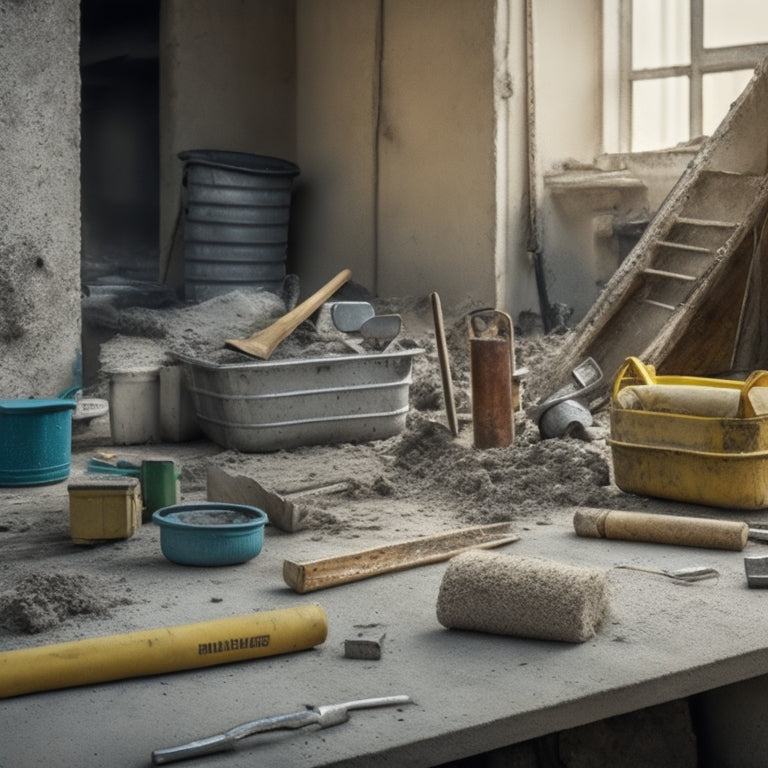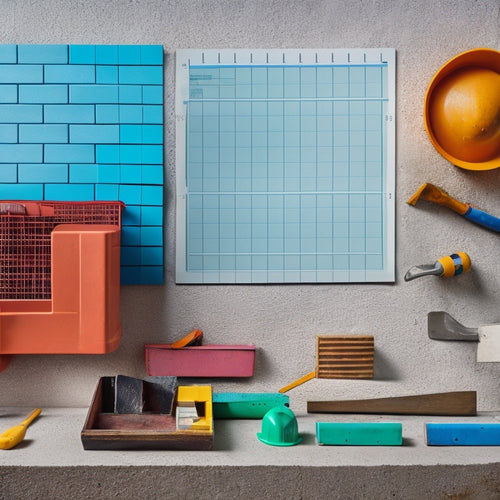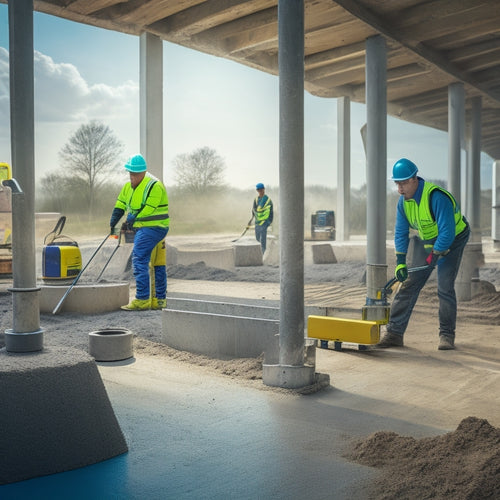
What Tools Do You Need for Concrete Walls
Share
As you commence on constructing concrete walls, you'll require a range of specialized tools. Mixing buckets, tamping tools, and measuring devices are fundamental for preparing the concrete mixture. Formwork materials, support frameworks, and shuttering techniques will shape the concrete. For a smooth finish, you'll need tamping tools, edging tools, and polishing equipment. Vibrating and compacting machines will guarantee the concrete is dense and strong. Additionally, you'll need safety gear, measuring and testing devices, cutting and drilling tools, and cleaning and maintenance equipment. You've got a lot to cover, and exploring these tools in more detail will be vital to achieving a high-quality concrete wall.
Key Takeaways
• Essential concrete mixing tools, such as mixing buckets, sticks, and paddles, are necessary for thorough mixing and removing air pockets.
• Formwork and shuttering equipment, including materials, support frameworks, and shuttering techniques, are required for shaping concrete.
• Concrete finishing and smoothening tools, like tamping tools, edging tools, and trowels, help achieve a refined surface.
• Vibrating and compacting machines, including internal and external vibrators and plate compactors, ensure dense and strong concrete.
• Safety gear, protective wear, and measuring/testing devices, such as hard hats, safety goggles, and laser levels, are crucial for a safe and accurate construction process.
Essential Concrete Mixing Tools
When preparing to pour a concrete wall, mixing the right consistency of concrete is essential. You'll need the following important tools to guarantee a successful mix.
A sturdy mixing bucket or drum is a must-have, as it will hold the concrete mixture securely while you mix. You'll also need a mixing stick or tamping tool to facilitate thorough mixing and to remove air pockets.
A mixing paddle or drill with a mixing bit is also necessary for efficient mixing. To achieve the perfect mixing ratio, you'll need a scale or measuring cups to accurately measure the cement, sand, and aggregate.
It's imperative to follow established mixing techniques and ratios to make sure the concrete reaches the desired strength and consistency. For instance, a common mixing ratio is 1 part cement to 2 parts sand to 3 parts aggregate.
Formwork and Shuttering Equipment
You'll need to set up a sturdy formwork and shuttering system to contain and shape the freshly poured concrete, guaranteeing it holds its form until it sets. This system consists of formwork materials such as plywood, steel, or aluminum panels, which are supported by a framework of beams, columns, and bracing. The formwork materials must be durable, waterproof, and resistant to deformation.
When selecting formwork materials, consider factors like the concrete's compressive strength, the size and shape of the wall, and the environmental conditions. You'll also need to choose the right shuttering techniques, such as Soldier beams, Waffle slab, or Insulated Concrete Forms (ICFs). These techniques will influence the final appearance and structural integrity of the concrete wall.
Remember to follow safety guidelines when handling and assembling the formwork and shuttering equipment. Ascertain the system is securely anchored to the ground, and all components are properly aligned and braced. By doing so, you'll minimize the risk of accidents and guarantee a successful concrete pour.
Concrete Finishing and Smoothening
As you move on to the finishing stage of your concrete wall project, you'll need to decide on the techniques to use to achieve a smooth, even surface.
You'll have to choose from various finishing methods, such as tamping, floating, and troweling, each suited to specific types of concrete and desired finishes.
Finishing Techniques Used
Regularly, contractors employ various finishing techniques to achieve a smooth, even surface on concrete walls, including tamping, edging, and floating. You'll want to master these techniques to produce high-quality results.
Tamping involves using a tamping tool to compact and flatten the concrete, removing any air pockets or imperfections. Edging is used to create a clean, defined edge around doors, windows, or other openings. Floating, on the other hand, helps to level and smooth out the surface, preparing it for further finishing.
To achieve a polished concrete finish, you may need to use additional techniques, such as grinding and polishing. Decorative finishes, like stamping or stenciling, can also be applied to create unique textures and patterns.
When working with concrete finishing, it's important to prioritize safety, wearing protective gear like gloves, safety glasses, and a dust mask to minimize exposure to dust and debris.
Smoothening Concrete Surfaces
With a solid foundation in finishing techniques established, smoothening concrete surfaces involves refining the surface further to achieve the desired level of smoothness and sheen.
You'll focus on eliminating any imperfections, such as air pockets, bumps, or scratches, to produce a uniform surface texture. To do this, you'll employ advanced trowel techniques, using a range of trowel sizes and angles to achieve the desired finish.
As you work, you'll need to contemplate the surface textures you're aiming for. Are you looking for a high-gloss finish, a matte finish, or something in between? The tools you use and the techniques you employ will vary depending on the texture you're trying to achieve. For example, a steel trowel is ideal for achieving a high-gloss finish, while a resin trowel is better suited for creating a matte finish.
Remember to work methodically, dividing the surface into sections and tackling each one systematically. This will help you maintain consistency and avoid missing any spots.
With patience and practice, you'll be able to achieve a smooth, even finish that meets your project's requirements.
Vibrating and Compacting Machines
You operate vibrating and compacting machines to consolidate freshly poured concrete, removing air pockets and excess water to achieve a dense, strong, and uniform finish. These machines play an essential role in guaranteeing the structural integrity and durability of your concrete walls.
When selecting a vibrating machine, consider the vibration frequency, which typically ranges from 3,000 to 12,000 vibrations per minute (vpm). A higher frequency is often used for thicker concrete slabs, while lower frequencies are suitable for thinner ones.
Compaction methods also vary depending on the machine and concrete type. Internal vibrators, for instance, are inserted into the concrete to vibrate it from within, while external vibrators are attached to the formwork to vibrate the concrete from the outside. Plate compactors and rollers are also used for surface compaction.
Always follow the manufacturer's guidelines and safety protocols when operating these machines to avoid accidents and guarantee ideal results. By using the right vibrating and compacting machines, you can achieve a high-quality concrete finish that meets your project's requirements.
Curing and Sealing Essentials
Proper curing and sealing of concrete walls is vital to preventing water infiltration, scaling, and cracks, and guaranteeing the long-term durability and aesthetic appeal of your structure.
You'll need to choose the right curing methods to make certain your concrete walls achieve peak strength and durability. This may involve applying a curing compound, using wet curing methods, or implementing a combination of both. It's imperative to follow the manufacturer's instructions for the specific curing product you're using.
Once your concrete walls have cured, you'll need to apply sealing products to protect them from the elements. You can choose from a range of sealing products, including acrylic, epoxy, and silane-based sealers. These products will help prevent water infiltration, reduce staining, and improve the overall appearance of your concrete walls.
When selecting a sealing product, consider factors such as the type of concrete, exposure to weather, and desired level of gloss. Always follow the manufacturer's instructions for application and make sure the surface is clean and dry before applying the sealer.
Safety Gear and Protective Wear
What personal protective equipment do you need to wear when working with concrete walls to prevent injuries and guarantee a safe working environment?
When handling concrete, it's vital to wear safety gear to protect yourself from physical harm. Start with a hard hat to shield your head from falling objects or debris.
Next, put on safety goggles to protect your eyes from flying particles or chemical splashes. These goggles should have impact-resistant lenses and a snug, comfortable fit.
Your hands are also at risk, so wear protective gloves to prevent cuts, abrasions, and skin irritation. Look for gloves made from durable materials like leather or synthetic fabrics that can withstand the rigors of concrete work.
Additionally, consider wearing a dust mask or respirator to filter out airborne particles and prevent respiratory issues.
Steel-toed boots or shoes with slip-resistant soles will help prevent foot injuries and slips.
Don't forget to wear long-sleeved shirts, long pants, and a dust-resistant jacket to protect your skin from concrete dust and debris.
Measuring and Testing Devices
As you begin constructing concrete walls, it's vital to guarantee accuracy and precision in your work. To achieve this, you'll need the right measuring and testing devices.
At least three essential measuring and testing devices are required to verify accurate concrete wall construction:
-
A laser level to ensure precise leveling and alignment,
-
A concrete test hammer to assess the wall's surface hardness,
-
A thermometer to monitor the ambient temperature and concrete temperature.
Here are the key devices you'll need:
-
Laser Level: Guarantees precise leveling and alignment, critical for maintaining structural integrity and preventing costly errors.
-
Concrete Test Hammer: Assesses the wall's surface hardness, helping you identify potential weaknesses or defects.
-
Thermometer: Monitors the ambient temperature and concrete temperature, allowing you to adjust your construction schedule and techniques accordingly.
Cutting and Drilling Tools
You'll need a range of cutting and drilling tools to efficiently and accurately shape and prepare concrete walls for various applications.
When it comes to cutting concrete, diamond blades are a must-have. These blades are designed to withstand the abrasive nature of concrete, providing a clean and precise cut. You'll want to choose a blade with the right diameter and segment type for your specific task, whether it's making straight cuts or curved cuts.
For drilling into concrete, you'll need a reliable core drill. Core drills are designed to extract a cylindrical core from the concrete, allowing you to create holes for pipes, anchors, or other fixtures. When selecting a core drill, consider the drill's power, speed, and bit type to guarantee you get the job done safely and efficiently.
It's also essential to wear proper personal protective equipment (PPE) when operating these tools, including gloves, safety glasses, and a dust mask.
Cleaning and Maintenance Tools
Maintaining a clean and organized workspace is essential when working with concrete walls.
Having the right cleaning and maintenance tools guarantees a smooth operation and prolongs the lifespan of your equipment.
You'll want to prioritize cleaning techniques that effectively remove dirt, dust, and debris without damaging your tools or the concrete surface.
To guarantee a safe and efficient workspace, you'll need the following cleaning and maintenance tools:
-
Brooms and dustpans: For sweeping away loose debris and dust from the workspace and tools.
-
Pressure washers: For intensive cleaning of concrete surfaces and equipment, especially after heavy use.
-
Soft-bristled brushes: For gently removing dust and dirt from sensitive tools and equipment.
Frequently Asked Questions
Can I Use Regular Gloves for Handling Concrete?
When handling concrete, you shouldn't rely on regular gloves for protection. They won't provide the necessary barrier against the alkaline nature of concrete, which can cause skin irritation and burns.
Instead, you need safety gear specifically designed for concrete work, such as heavy-duty gloves made from materials like rubber, neoprene, or PVC.
Look for glove types with reinforced palms, fingers, and cuffs to guarantee maximum protection.
Do I Need a Permit to Build a Concrete Wall?
Imagine yourself building a concrete wall, the sound of cement mixers humming in the background, the smell of fresh concrete filling the air.
But, before you start, you need to ask yourself: do you need a permit? The answer is, it depends on your location and the wall's purpose.
Check with local authorities to determine if you need to comply with permit regulations.
Make certain you understand the rules governing wall construction in your area to avoid costly fines and ensure a safe, structurally sound wall.
How Long Does It Take for Concrete to Fully Cure?
When you pour concrete, you'll wonder how long it takes for it to fully cure.
The curing process is essential, as it directly affects the concrete's strength and durability. The curing time depends on factors like temperature, humidity, and mix design.
Typically, concrete reaches 70% strength within 7-10 days, but it takes 28 days to fully cure.
You'll need to guarantee proper curing conditions, like keeping it moist and protected from extreme temperatures, to achieve ideal results.
Can I Paint Over Concrete Without Special Preparation?
Did you know that concrete takes up to 28 days to fully cure?
Now, about painting over concrete: you can't just slap on a coat without prep. For ideal paint adhesion, you need to verify the surface is free of dirt, oil, and old adhesives.
Proper surface preparation is key, involving cleaning, etching, and applying a bonding agent. Skipping these steps can lead to peeling and flaking.
Take the time to do it right, and your paint job will last for years to come.
Is It Necessary to Waterproof a Concrete Wall?
When building or renovating with concrete walls, you'll want to make certain they're protected from water damage.
It's crucial to waterproof a concrete wall to prevent moisture infiltration, which can lead to structural issues and safety hazards.
You'll need to apply effective waterproofing techniques, such as sealing cracks and joints, and installing moisture barriers to prevent water seepage.
Don't risk compromising the integrity of your structure - take the necessary steps to safeguard your concrete walls against water damage.
Conclusion
As you stand before your newly built concrete wall, you're not quite done yet. The tools you've gathered are just the beginning.
Now, the real challenge begins - ensuring your wall stands the test of time. Will you be able to maintain its strength and integrity?
The fate of your structure hangs in the balance, and it's up to you to make the right moves.
Related Posts
-

Concrete Foundation Building Tools for Homeowners' Success
As you start your concrete foundation building project, it is vital to have the right tools to guarantee success. You...
-

Reinforcement Tools Checklist for Concrete Block Walls
You'll need a range of reinforcement materials, including horizontal and vertical rebar, fiber mesh, and anchor bolts...
-

What Tools Ensure Precise Concrete Leveling Results
You need a range of specialized tools to achieve precise concrete leveling results. Laser leveling instruments provid...


